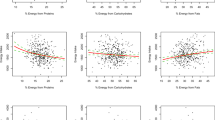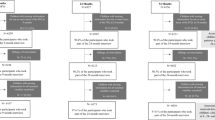Abstract
Objectives:
To evaluate possible associations between body mass index (BMI) at 4 years of age, current and previous dietary intakes and parental BMI.
Methods:
A follow-up of dietary intake and anthropometry in 127 4-year-old children corresponding to 54% of children who completed an initial intervention study at 18 months of age.
Results:
Fourteen percent of the girls and 13% of the boys were overweight (age-adjusted BMI⩾25) and 2% of the girls and 3% of the boys were obese (age-adjusted BMI⩾30). Thirty-four percent and 9% of the fathers and 19 and 7% of the mothers were overweight and obese, respectively. BMI at 6–18 months was a strong predictor of BMI at 4 years. Univariate regression analyses revealed that intake of protein in particular, and also of total energy and carbohydrates at 17/18 months and at 4 years, was positively associated with BMI at 4 years. Although BMI at 6–18 months was the strongest predictor of BMI at 4 years, in the final multivariate models of the child's BMI, protein intake at 17–18 months and at 4 years, energy intake at 4 years and the father's—but not the mother's—BMI were also independent contributing factors.
Conclusions:
Among these healthy children, BMI at 4 years of age tracked from 6 to 18 months of age and were associated with previous and current protein intake as well as parental BMI, particularly that of the father.
This is a preview of subscription content, access via your institution
Access options
Subscribe to this journal
Receive 12 print issues and online access
$259.00 per year
only $21.58 per issue
Buy this article
- Purchase on Springer Link
- Instant access to full article PDF
Prices may be subject to local taxes which are calculated during checkout


Similar content being viewed by others
References
Aeberli I, Kaspar M, Zimmermann MB (2007). Dietary intake and physical activity of normal weight and overweight 6 to 14 year old Swiss children. Swiss Med Wkly 137, 424–430.
Aggett PJ, Haschke F, Heine W, Hernell O, Koletzko B, Lafeber H et al. (1994). Committee report: childhood diet and prevention of coronary heart disease. ESPGAN Committee on Nutrition. European Society of Pediatric Gastroenterology and Nutrition. J Pediatr Gastroenterol Nutr 19, 261–269.
Altman DG, Royston P (2006). The cost of dichotomising continuous variables. Br Med J 332, 1080.
Blomquist HK, Bergström E (2007). Obesity in 4-year-old children more prevalent in girls and in municipalities with a low socioeconomic level. Acta Paediatr 96, 113–116.
Burke V, Beilin LJ, Dunbar D (2001). Family lifestyle and parental body mass index as predictors of body mass index in Australian children: a longitudinal study. Int J Obes Relat Metab Disord 25, 147–157.
Burke V, Beilin LJ, Simmer K, Oddy WH, Blake KV, Doherty D et al. (2005). Predictors of body mass index and associations with cardiovascular risk factors in Australian children: a prospective cohort study. Int J Obes (Lond) 29, 15–23.
Cole TJ, Bellizzi MC, Flegal KM, Dietz WH (2000). Establishing a standard definition for child overweight and obesity worldwide: International survey. Br Med J 320, 1240–1243.
Demol S, Yackobovitch-Gavan M, Shalitin S, NagCelberg N, Phillip M (2009). Low-carbohydrate (low and high-fat) versus high-carbohydrate low-fat diets in the treatment of obesity in adolescents. Acta Paediatr 98, 346–351.
Ekblom O, Oddsson K, Ekblom B (2004). Prevalence and regional differences in overweight in 2001 and trends in BMI distribution in Swedish children from 1987 to 2001. Scand J Public Health 32, 257–263.
Elmståhl S, Gullberg B (1997). Bias in diet assessment methods–consequences of collinearity and measurement errors on power and observed relative risks. Int J Epidemiol 26, 1071–1079.
Garemo M, Arvidsson Lenner R, Nilsson EK, Borres MP, Strandvik B (2007a). Food choice, socio-economic characteristics and health in 4-year olds in a well-educated urban Swedish community. Clin Nutr 26, 133–140.
Garemo M, Lenner RA, Strandvik B (2007b). Swedish pre-school children eat too much junk food and sucrose. Acta Paediatr 96, 266–272.
Garemo M, Strandvik B (2006). Metabolic markers in relation to nutrition and growth in healthy 4-y-old children in Sweden. Am J Clin Nutr 84, 1021–1026.
Gunther AL, Remer T, Kroke A, Buyken AE (2007). Early protein intake and later obesity risk: which protein sources at which time points throughout infancy and childhood are important for body mass index and body fat percentage at 7 y of age? Am J Clin Nutr 86, 1765–1772.
Hermanussen M, Tresguerres JAF (2007). Overweight, appetite control, and the role of glutamate and excess nutritional protein during child development. Hum Ontogenet 1, 23–35.
Hoppe C, Molgaard C, Juul A, Michaelsen KF (2004a). High intakes of skimmed milk, but not meat, increase serum IGF-I and IGFBP-3 in eight-year-old boys. Eur J Clin Nutr 58, 1211–1216.
Hoppe C, Molgaard C, Thomsen B, Juul A, Michaelsen KF (2004b). Protein intake at 9 mo of age is associated with body size but not with body fat in 10-y-old Danish children. Am J Clin Nutr 79, 494–501.
Hoppe C, Udam TR, Lauritzen L, Molgaard C, Juul A, Michaelsen KF (2004c). Animal protein intake, serum insulin-like growth factor I, and growth in healthy 2.5-y-old Danish children. Am J Clin Nutr 80, 447–452.
Huus K, Ludvigsson JF, Enskar K, Ludvigsson J (2007). Risk factors in childhood obesity-findings from the all babies in Southeast Sweden (ABIS) cohort. Acta Paediatr 96, 1321–1325.
Karlberg J, Luo ZC, Albertsson-Wikland K (2001). Body mass index reference values (mean and s.d.) for Swedish children. Acta Paediatr 90, 1427–1434.
Kivimaki M, Lawlor DA, Smith GD, Elovainio M, Jokela M, Keltikangas-Jarvinen L et al. (2007). Substantial intergenerational increases in body mass index are not explained by the fetal overnutrition hypothesis: the cardiovascular risk in young Finns study. Am J Clin Nutr 86, 1509–1514.
Koletzko B, von Kries R, Monasterolo RC, Subias JE, Scaglioni S, Giovannini M et al. (2009). Can infant feeding choices modulate later obesity risk? Am J Clin Nutr 89, 1502S–1508S.
Lind T, Lönnerdal B, Persson LÅ, Stenlund H, Tennefors C, Hernell O (2003). Effects of weaning cereals with different phytate contents on hemoglobin, iron stores, and serum zinc: a randomized intervention in infants from 6 to 12 mo of age. Am J Clin Nutr 78, 168–175.
Lind T, Persson L, Lönnerdal B, Stenlund H, Hernell O (2004). Effects of weaning cereals with different phytate content on growth, development and morbidity: a randomized intervention trial in infants from 6 to 12 months of age. Acta Paediatr 93, 1575–1582.
Livingstone MB, Black AE (2003). Markers of the validity of reported energy intake. J Nutr 133, 895S–920S.
Mårild S, Bondestam M, Bergström R, Ehnberg S, Hollsing A, Albertsson-Wikland K (2004). Prevalence trends of obesity and overweight among 10-year-old children in western Sweden and relationship with parental body mass index. Acta Paediatr 93, 1588–1595.
NNR (2004). Nordic Nutrition recommendations 2004. Nordic council of ministers: Copenhagen.
Öhlund I, Lind T, Hörnell A, Hernell O (2008). Predictors of iron status in well-nourished 4-y-old children. Am J Clin Nutr 87, 839–845.
Petersen S, Brulin C, Bergström E (2003). Increasing prevalence of overweight in young schoolchildren in Umeå, Sweden, from 1986 to 2001. Acta Paediatr 92, 848–853.
Reilly JJ, Armstrong J, Dorosty AR, Emmett PM, Ness A, Rogers I et al. (2005). Early life risk factors for obesity in childhood: cohort study. Br Med J 330, 1357.
Rolland-Cachera MF, Deheeger M, Akrout M, Bellisle F (1995). Influence of macronutrients on adiposity development: a follow up study of nutrition and growth from 10 months to 8 years of age. Int J Obes Relat Metab Disord 19, 573–578.
Rolland-Cachera MF, Deheeger M, Bellisle F (2001). Early adiposity rebound is not associated with energy or fat intake in infancy. Pediatrics 108, 218–219.
Roos G, Prattala R, Koski K (2001). Men, masculinity and food: interviews with Finnish carpenters and engineers. Appetite 37: 47–56.
Saunders KL (2007). Preventing obesity in pre-school children: a literature review. J Public Health (Oxf) 29, 368–375.
Silfverdal SA, Hernell O (2008). Who is responsible for dietary advice for our children? Läkartidningen 105, 1863–1864.
Sjöberg A, Lissner L, Mårild S (2008). Recent anthropometric trends among Swedish school children: evidence for decreasing prevalence of overweight in girls. Acta Paediatr 97, 118–123.
Slaughter MH, Lohman TG, Boileau RA, Horswill CA, Stillman RJ, Van Loan MD et al. (1988). Skinfold equations for estimation of body fatness in children and youth. Hum Biol 60, 709–723.
The National Food Administration (2006). Dietary habits and nutrient intake in Swedish children 4 year old and school children in grade 2 and 5 (Riksmaten - barn 2003) Uppsala, National Food Administration (Livsmedelsverket), Uppsala, Sweden.
Vogels N, Posthumus DL, Mariman EC, Bouwman F, Kester AD, Rump P et al. (2006). Determinants of overweight in a cohort of Dutch children. Am J Clin Nutr 84, 717–724.
Von Post-Skagegard M, Samuelson G, Karlström B, Mohsen R, Berglund L, Bratteby LE (2002). Changes in food habits in healthy Swedish adolescents during the transition from adolescence to adulthood. Eur J Clin Nutr 56: 532–538.
Wang Y, Lobstein T (2006). Worldwide trends in childhood overweight and obesity. Int J Pediatr Obes 1, 11–25.
Whitaker RC (2004). Predicting preschooler obesity at birth: the role of maternal obesity in early pregnancy. Pediatrics 114, e29–e36.
Williams S (2001). Overweight at age 21: the association with body mass index in childhood and adolescence and parents’ body mass index. A cohort study of New Zealanders born in 1972–1973. Int J Obes Relat Metab Disord 25, 158–163.
WHO (2006). WHO child growth standards: length/height -for-age, weight-for-length, weight-for-height and body mass index-for-age:methods and development. World Health Organization: Geneva.
WHO (2007). Protein and amino acid requirements in human nutrition. World Health organization: Geneva.
Acknowledgements
We are most grateful to all of the participating children and their parents, and to research nurse Margareta Henriksson for invaluable assistance in collecting the data. We are also grateful to the dieticians Maria Sehlstedt, Anna Karlsson and Agneta Frängsmyr for tabulating the dietary data. This study was supported by grants from the Goljes Memory Foundation, the Oskar Foundation, the Axel Adlers Foundation and the Mayflower Charity Foundation.
Author information
Authors and Affiliations
Corresponding author
Additional information
Contributors: IÖ is the main author of this paper; she has also participated in the planning of the study, food data collection and analyses. OH and TL contributed to the planning and data analyses and in writing the manuscript. AH took part in the data analyses and in writing of the manuscript. HS took part in the statistical analyses.
Rights and permissions
About this article
Cite this article
Öhlund, I., Hernell, O., Hörnell, A. et al. BMI at 4 years of age is associated with previous and current protein intake and with paternal BMI. Eur J Clin Nutr 64, 138–145 (2010). https://doi.org/10.1038/ejcn.2009.132
Received:
Revised:
Accepted:
Published:
Issue Date:
DOI: https://doi.org/10.1038/ejcn.2009.132
Keywords
This article is cited by
-
Study protocol: optimized complementary feeding study (OTIS): a randomized controlled trial of the impact of a protein-reduced complementary diet based on Nordic foods
BMC Public Health (2019)
-
High protein intake along with paternal part-time employment is associated with higher body fat mass among girls from South China
European Journal of Nutrition (2018)
-
Parental body mass index and its association with body composition, physical fitness and lifestyle factors in their 4-year-old children: results from the MINISTOP trial
European Journal of Clinical Nutrition (2017)
-
Protein intake in early childhood and body composition at the age of 6 years: The Generation R Study
International Journal of Obesity (2016)
-
Energy and macronutrient intakes and adherence to dietary guidelines of infants and toddlers in Belgium
European Journal of Nutrition (2016)



